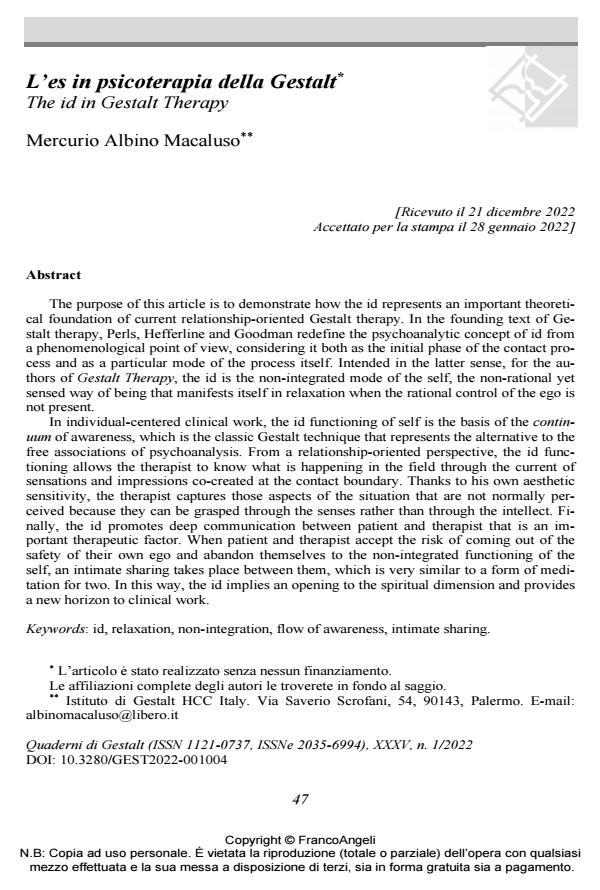The id in Gestalt Therapy
Journal title QUADERNI DI GESTALT
Author/s Mercurio Albino Macaluso
Publishing Year 2022 Issue 2022/1
Language Italian Pages 21 P. 47-67 File size 275 KB
DOI 10.3280/GEST2022-001004
DOI is like a bar code for intellectual property: to have more infomation
click here
Below, you can see the article first page
If you want to buy this article in PDF format, you can do it, following the instructions to buy download credits

FrancoAngeli is member of Publishers International Linking Association, Inc (PILA), a not-for-profit association which run the CrossRef service enabling links to and from online scholarly content.
The purpose of this article is to demonstrate how the id represents an important theoretical foundation of current relationship-oriented Gestalt therapy. In the founding text of Gestalt therapy, Perls, Hefferline and Goodman redefine the psychoanalytic concept of id from a phe-nomenological point of view, considering it both as the initial phase of the contact process and as a particular mode of the process itself. Intended in the latter sense, for the authors of Gestalt Therapy, the id is the non-integrated mode of the self, the non-rational yet sensed way of be-ing that manifests itself in relaxation when the rational control of the ego is not present. In individual-centered clinical work, the id functioning of self is the basis of the continuum of awareness, which is the classic Gestalt technique that represents the alternative to the free associations of psychoanalysis. From a relationship-oriented perspective, the id functioning allows the therapist to know what is happening in the field through the current of sensations and impressions co-created at the contact boundary. Thanks to his own aesthetic sensitivity, the therapist captures those aspects of the situation that are not normally perceived because they can be grasped through the senses rather than through the intellect. Finally, the id pro-motes deep communication between patient and therapist that is an important therapeutic fac-tor. When patient and therapist accept the risk of coming out of the safety of their own ego and abandon themselves to the non-integrated functioning of the self, an intimate sharing takes place between them, which is very similar to a form of meditation for two. In this way, the id implies an opening to the spiritual dimension and provides a new horizon to clinical work.
Keywords: id, relaxation, non-integration, flow of awareness, intimate sharing.
Mercurio Albino Macaluso, L’es in psicoterapia della Gestalt in "QUADERNI DI GESTALT" 1/2022, pp 47-67, DOI: 10.3280/GEST2022-001004